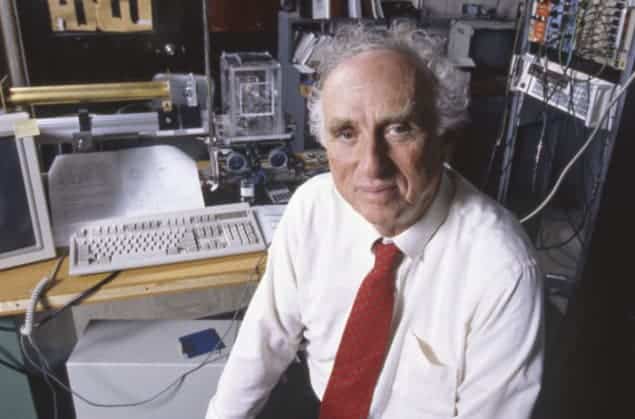
The US particle physicist Martin Perl has died at the age of 87. Perl was instrumental in discovering the tau lepton – an elementary particle similar to the electron but 3477 times heavier. The work led him to share the 1995 Nobel Prize for Physics with Frederick Reines, who discovered the neutrino, for their “pioneering experimental contributions to lepton physics”.
Born in New York City on 24 June 1927, Perl originally trained as a chemical engineer, obtaining a degree in the subject at the Brooklyn Polytechnic Institute in 1948. He then went on to work for General Electric, where he was involved in producing electron vacuum tubes. It was there that Perl’s interests turned to physics, and he began to enrol in physics courses at Union College in New York.
In 1955 Perl was awarded a PhD in physics from Columbia University, which he did under the supervision of the 1944 physics Nobel laureate Israel Isaac Rabi. Perl’s thesis applied Rabi’s nuclear-magnetic-resonance technique to measure the nuclear quadrupole moment of sodium. After his PhD, Perl moved into particle physics, heading to the University of Michigan, where he used bubble chambers to study the scattering of pions with nucleons.
The third generation
In 1963 Perl joined the Stanford Linear Accelerator Center (SLAC), and it was there that he carried out his Nobel-prize-winning work in the 1970s. We now know that three generations of leptons and quarks make up the known fundamental matter states in the universe, but in the early 1970s only two generations of leptons were known to exist. The first consists of the electron and its associated neutrino – the electron neutrino (together with their antiparticles) – while the second generation includes the muon and the muon neutrino.
Perl’s discovery opened up the third generation of elementary particles. In 1972 SLAC had just completed the SPEAR electron–positron collider, which could collide electrons and positrons at a then-record energy of 4.8 GeV (later reaching 8 GeV). In conjunction with the magnetic detector – developed at the Lawrence Berkeley National Laboratory – the facility could detect and distinguish between leptons, hadrons and photons.
Using SPEAR between 1974 and 1977, Perl and colleagues observed events in which the electron–positron annihilation produced electron–antimuon or positron–muon pairs with an energy less than the initial energy and with no other particles visible. Perl’s interpretation was that the initial electron–positron pair had annihilated to produce a new lepton–antilepton pair, which Perl dubbed the tau–lepton pair. The tau then decayed into an electron (or muon) plus two undetected neutrinos, while the antitau decayed into an antimuon (or positron) and two neutrinos.
Given that the signal could be explained by other events, some particle physicists were initially sceptical about the discovery. What finally convinced the community that the tau lepton had been discovered was when Perl’s results were later confirmed by the DESY particle-physics lab in Hamburg, Germany, as well as by further experiments at SPEAR.
Perl was active in physics until the end of his life. Indeed, recently he had turned his sights on experiments to understand the nature of dark energy. One such proposal, in 2011, involved dropping caesium atoms through two 1.5 m-long atom interferometers in the hope of detecting any hitherto unknown “dark content of the vacuum”.



